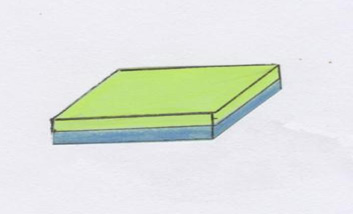Level 3: Multiplicative Thinking
Materials:
- 12 square tiles glued together in pairs one on top of the other and displayed on a card so that one pair can be exposed without exposing the others (eg, see below)
- something to hide the tiles, eg, a paper plate or piece of card
- a single square tile
- 87 unifix blocks in a container
Instructions:
Bold type indicates what should be said.
Say, “I’m interested in how people count by threes. If you count to twelve by threes, how many threes would you count? … Observe student’s response, in particular, the extent to which he/she marks the count in some way (eg, by using fingers).If the student clearly needs to model the count in some way, ask him/her to explain their strategy then proceed to the square tiles task. If completed quickly and easily, omit the square tiles task and proceed to the unifix task.
Ask the student to close his/her eyes while the 12 tiles, glued together in pairs, are placed under the paper plate. Ask the student to open his/her eyes and while showing the student the single tile, say, “There are twelve of these tiles under the paper plate”. Carefully slide the paper plate to show the student a single pair of tiles, replace and ask, “How many twos do you think are under here?” … Observe student’s response, in particular, the extent to which he/she marks the count. If done relatively easily, proceed to the Unifix task.
Place 87 Unifix blocks in front of the student and say, “There are 87 blocks in this container. Can you make sticks of ten?”…. If student moves to make sticks of ten, interrupt after one stick has been made and ask, “How many stacks of ten could you make like that?” … Note student’s response … If the student suggests or continues making sticks of ten, interrupt again and say, “Let’s just pretend that you have made all the sticks, how many would there be?” Observe student’s response.

3.1 Advice Rubric
This task examines the extent to which students recognise numbers as abstract composite wholes (ie, as countable units in the absence of physical materials/models). The idea that a count can be counted is a difficult notion for some students but it is an essential underpinning for place-value, multiplication and division. This task should only be used where students have demonstrated some capacity to physically count collections by twos, fives and tens.
| Observed response |
Interpretation/Suggested teaching response |
|---|
Little/no response to initial imaginary task, some attempt to solve square tile task |
May not understand task or unable to work with 2 and/or 3 as mental objects
- Consolidate part-part-whole knowledge using Subitising Cards (see Level 1 )
- Practice counting larger collections by 2s and 5s
|
Able to keep track of count of threes and/or twos, but unable to say how many tens would be made |
Suggests some capacity to work with 2 and/or 3 as mental objects, may not be able to sustain this for 6 or more groups, may not trust the count of 10 or see 2 digit numbers in terms of a count of tens and ones
- Introduce arrays as a more efficient way to count larger collections, encourage the use of doubling
- Practice making, naming and recording tens and ones, emphasising the count of tens in the tens place and the count of ones in the ones place
- Reinforce notion of ten as a countable unit by counting bundles of ten sticks or MAB tens to 10 tens and beyond (eg, 1 ten, 2 tens, … 9 tens, 10 tens, 11 tens, 12 tens …23 tens … etc.). Explore patterns in recording, eg, 6 tens recorded as 60 so 23 tens recorded as 230 (this should NOT be interpreted as “adding a zero”, but as how we name tens, 0 is recorded to indicate that there are no ones)
|
Able to say how many tens would be made |
Can work with 2 and 3 as mental objects, appears to understand the basis on which 2-digit numbers are recorded
- Consolidate 2-digit place-value by comparing two numbers presented in different ways (eg, 3 MAB tens and 17 ones and a card showing 46, which is bigger/smaller? Why/how do you know?), ordering/sequencing (order 5 or more 2-digit numbers or place in sequence on a rope from 0 to 100, discuss and refine strategies), counting forwards and backwards in place-value parts starting anywhere (eg, 27, 37, 47 (clap), 46, 45, 44, 43, …), and by renaming (eg, 45 is 4 tens and 5 ones or 45 ones, which is easier to see?)
- Practice reading to the tens place to identify the count of tens, consider using open number lines to support place-value based strategies for addition and subtraction of 2-digit numbers
- Introduce and/or consolidate 3-digit place-value, in particular make, name and record 3 digit numbers using MAB and consolidate through comparing, ordering, sequencing, counting forwards and backwards in place-value parts (see Number Chart Activities (pdf - 60.87kb)), and renaming.
|